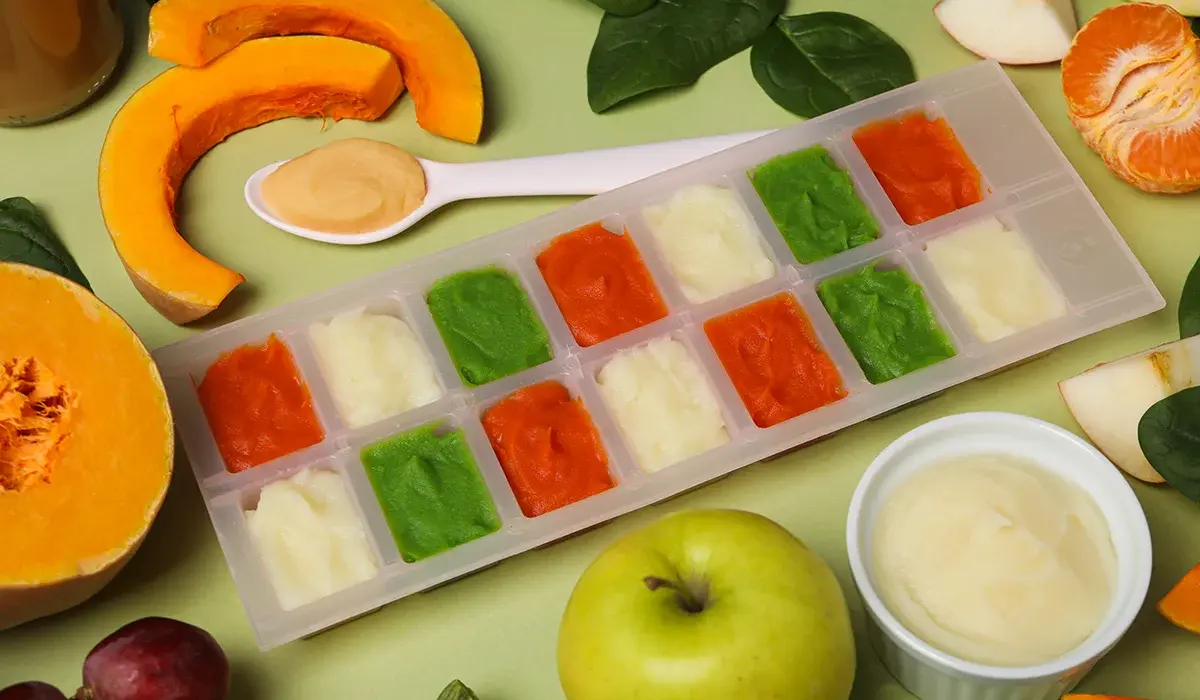Breastfeeding & Baby Feeding
Save Time and Stress with These Frozen Baby Food Tips

Frozen Baby Food Tips for Smart, Healthy Feeding
Preparing homemade baby food helps you save money while giving your baby fresh, nutritious meals every single day.
Parents often prefer freezing baby meals because it keeps food safe, flavorful, and convenient without sacrificing essential nutrition.
However, it’s easy to feel overwhelmed when trying to store, thaw, or choose the right foods for freezing.
Don’t worry—this guide shares expert-approved frozen baby food tips to help you feed your baby safely and confidently.
Why Freezing Baby Food Makes Sense
Homemade baby food is great, but preparing it daily is exhausting. That’s where freezing steps in as a game-changer.
Freezing baby food allows you to cook in batches and save meals for later while keeping the nutritional value intact.
Alicia Chacha Miller, RD, says freezing baby food supports busy parents and helps maintain a variety of healthy food options.
You’ll reduce food waste, save valuable time, and always have meals ready for your hungry baby.
Dr. Pierrette Poinsett, a pediatrician, agrees and encourages freezing baby food in small portions for safety and convenience.
Methods of Freezing Baby Food Properly
Several methods exist for freezing baby food. One of the easiest ways is using standard ice cube trays in your freezer.
Pour the puree into each cube, freeze it, then transfer the cubes into labeled zip-lock freezer bags for storage.
Each cube equals about one ounce of food, which helps parents serve the correct portion during mealtime.
Additionally, consider using silicone baby food containers. These flexible trays release frozen food easily and are usually BPA-free.
Frozen Baby Food Tips for Storage Safety
Never freeze baby food in non-freezer-safe glass jars. Food expands when frozen, which could crack jars and cause contamination.
Instead, always choose BPA-free plastic or silicone containers labeled safe for freezer use to avoid any safety risks.
Label every container with the date of freezing. This helps you track freshness and know when to discard expired food.
Store food in two to four-ounce portions. That way, you’ll reduce waste when your baby eats only small amounts.
Some parents use breastmilk storage bags or flat freezer bags for space-saving and easy thawing.
What Baby Foods Freeze the Best?
Most purees freeze beautifully. Think of soft fruits, vegetables, and cooked meats—each holds up well during freezing and thawing.
Sweet potatoes, peas, carrots, and butternut squash are top choices because they maintain texture and flavor after freezing.
Pureed fruits like peaches, pears, and blueberries also store well and retain their nutrients when thawed correctly.
Cooked meats such as chicken, turkey, beef, and fish freeze safely. Always cook meat before freezing for baby meals.
Dr. Poinsett warns that raw proteins aren’t safe for freezing unless cooked first to kill harmful bacteria.
Frozen Baby Food Tips: Fruits to Watch
Some fruits—like bananas, apples, strawberries, and avocados—brown quickly when frozen. However, browning only affects appearance, not safety.
To minimize browning, add a splash of lemon juice before freezing. That helps preserve the food’s bright and fresh appearance.
You can also choose to mash these fruits fresh before serving instead of freezing them in advance.
Other foods like citrus, melons, and mangoes may freeze better in chunks and should be pureed after thawing.
How Long to Store Baby Food in the Freezer?
Homemade baby food keeps well for one to three months in the freezer, according to the FDA and most pediatricians.
Technically, food can last up to six months, but quality and nutritional value drop the longer it’s frozen.
For the best results, use frozen homemade meals within the first three months after preparation.
Store-bought baby foods, however, are pasteurized. That allows them to remain frozen and safe for up to six to eight months.
Always check expiration dates and follow manufacturer storage instructions for packaged frozen baby foods.
Frozen Baby Food Tips: Keeping Track of Time
Use a marker to write the freeze date on each container. This simple habit prevents confusion and supports better planning.
Rotate food regularly by placing newer containers behind older ones in the freezer to ensure you use older food first.
Also, throw away any container that’s cracked, smells off, or shows signs of freezer burn.
How to Thaw Frozen Baby Food Safely
The safest thawing method is transferring the container to your refrigerator and letting it defrost overnight.
This gradual process reduces bacteria risk and preserves the food’s taste, texture, and nutritional integrity.
Never thaw baby food on your kitchen counter. Room temperature promotes bacterial growth, which could make your baby sick.
If time is short, use the microwave’s defrost setting. Stir the food well and test the temperature before serving.
You can also place the sealed container under warm running water or heat gently in a saucepan on the stove.
Always stir and test temperature to prevent accidental burns from uneven heating.
Safety Tips After Thawing
Cleanliness matters. Wash your hands with warm soapy water before touching your baby’s food or feeding equipment.
Sterilize containers and spoons to prevent harmful bacteria from affecting your baby’s still-developing immune system.
Discard any leftover baby food that has touched your baby’s mouth or saliva. Bacteria spread quickly, so play it safe.
If your baby didn’t touch the thawed portion, you can refrigerate it for up to two days—but never refreeze it.
Dr. Poinsett emphasizes, “Do not refreeze baby food after it has been thawed, even if your baby hasn’t eaten it.”
Always trust your senses. If the food smells sour, looks off, or feels slimy, it’s best to throw it away.
Extra Frozen Baby Food Tips for Success
Batch cook once a week to reduce daily stress and always have meals on hand for your baby’s feeding schedule.
Create a freezer inventory list. Note what foods you’ve frozen and when, so you don’t lose track of storage times.
Use color-coded containers to separate veggies, fruits, and proteins. That makes meal planning faster and more organized.
Let your baby explore different flavors. Freezing allows you to offer variety without having to prepare fresh meals each time.
Ask your pediatrician about new ingredients or allergens before introducing frozen meals with multiple ingredients.
When to Skip Freezing Baby Food
Skip freezing if you’re unsure about the food’s freshness or haven’t cleaned preparation tools thoroughly.
Also avoid freezing foods with thick dairy, like full-fat yogurt or cheese, since they may separate or change texture after thawing.
Finally, don’t freeze large batches unless you’ve tested how your baby reacts to the food first. Avoid wasting food unnecessarily.
Conclusion: Make Freezing Work for You
Homemade frozen baby food offers flexibility, nutrition, and peace of mind for busy parents who want the best for their babies.
You don’t have to freeze every meal—combine fresh, frozen, and store-bought options depending on your time and energy.
Follow these frozen baby food tips to ensure safety, efficiency, and mealtime success with every bite your baby enjoys.
Always check with your pediatrician for guidance if you’re unsure about specific ingredients or feeding practices.
Explore more news on this website for expert parenting tips, healthy recipes, and smart home strategies.












